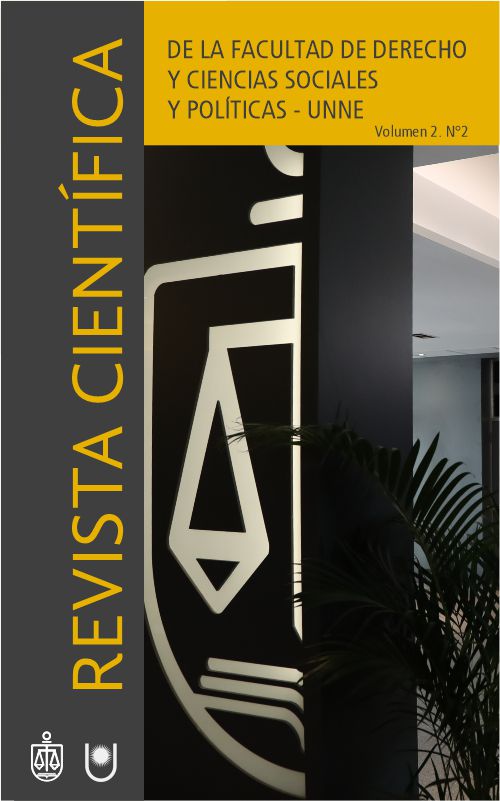The slaving experience in the urban economic and social frames. The case of the Soto family
DOI:
https://doi.org/10.30972/rcd.226737Keywords:
stipendary slavery, inheritance, Corrientes elite, modalities of slaveryAbstract
The article will refer to the singularities of the urban slavery experience in the economic and social frameworks at the end of the 18th century and the beginning of the 19th century. In particular, the case of the Soto family is analyzed in terms of evidencing different features that allow it to be characterized as part of the local elites. Thus, the study of it is based on its relevance in local history and significant influence on the conformation and organization of Goya. Based on which, a historiographical analysis and a study of legal hermeneutics are carried out, which includes an unpublished private archive of the Soto family, which makes it possible to apprehend slavery socio-historically in the Corrientes subregion. In this way, a comparative analysis of the macro context of the time is carried out considering the non-Spanish and Spanish-American colonies. In general, in the United States and Brazil, the work of black slaves was predominantly linked to the economic exploitation of plantations. However, the trend allows us to establish a differentiation with respect to Latin America, where slavery was fundamentally urban and domestic. However, it cannot be ruled out that, to a lesser extent, other forms of slavery coexisted in both cases. In this framework, the analysis that goes from the general to the particular, the study of the characteristics of urban slavery, the economy and society in the Río de la Plata, in the Corrientes subregion and in the origins of the city of Goya.References
Archivo General de la Provincia de Corrientes. Censos de Corrientes en 1820. Tomo III, Folio 17-18.
Archivo General de la Provincia de Corrientes. Censos de Corrientes en 1825. Tomo VII, Folio 5.
Archivo General de la Provincia de Corrientes. Censos de Corrientes en 1825. Tomo VII, Folio 26.
Archivo General de la Provincia de Corrientes. Censos de Corrientes en 1825. Tomo VII, Folio13.
Archivo General de la Provincia de Corrientes. Expedientes Notariales Corrientes. Sala I, Tomo 33, Foja 170.
Archivo privado familiar Soto-Dávila. Hijuelas del 22 marzo 1824.
Archivo privado familiar Soto-Dávila. Hijuelas del 29 noviembre 1834.
Bernand, C. (2001). Negros esclavos y libres en las ciudades hispanoamericanas. Fundación Histórica Tavera.
Borucki, A. (2005) ¿Es posible integrar la esclavitud al relato de la historia económica uruguaya previa a 1860? Boletín de Historia Económica, núm. 4. Departamento de Historiología de la Facultad de Humanidades y Ciencias de la Educación, Universidad de la República. http://www.audhe.org.uy/Boletin_Audhe/Boletin_4/AUDHE_No_04_Borucki.pdf
Cafferata Soto, J. D. (1982). Geografía de Corrientes. Editorial Correntina.
Caño Ortigosa, J. L. (2022) Mujeres y compraventa de esclavas en Guanajuato colonial (1700-1750). Temas Americanistas, núm. 49. https://revistascientificas.us.es/index.php/Temas_Americanistas/article/view/21643/20253
Cassani, A. P. (1993). Por qué existió la esclavitud y por qué en Goya. Ediciones Ocruxaves.
Cassani, P. A. (1960). Recopilación de datos y ensayo histórico referentes a la ciudad de Goya. 1ra edición, Argentina. En DALLA VECCHIA, Agostinho Mario (1994). Os filhos da escravidão: memórias de descendentes de escravos da região meridional do Rio Grande do Sul. Editora Unniversitária. UFPEL.
Cassani, P. A. (1989). Historia del Templo de Goya, Actual Catedral. Ediciones Ocruxaves.
Castello, A. E. (1984). Historia de Corrientes. Editorial Plus Ultra.
Cruz Jaime, J. (2002). Corrientes. Poder y aristocracia. Letemendia Casa Editora.
De Carranza, A. (1977). El Puerto que llaman de Goya Etimología de su nombre. Separata. Academia Nacional de la Historia, Buenos Aires.
Decreto N° 472 de 2020. 14 de Mayo de 2020. Área Urbana Histórica Nacional y Área de Amortiguación Visual.
De Labougle, R. (1962). Orígenes de la ganadería en Corrientes: siglo XVI y XVII. S/E.
Giberti, H. (1986). Historia económica de la ganadería argentina. Hyspanoamérica.
Golberg, M. y Mallo, S. (2005). Vida y muerte cotidiana de los negros en el Río de la Plata en GALLEGO, J. A. (dir.), Afroamérica, la tercera raíz. Tres grandes cuestiones de la Historia de Iberoamérica. Mapfre.
Grosse, E. W. (2020). La ciudad de Goya: determinantes del poblamiento y la razón de su nombre. Damián de Marco Editorial.
Karasch, M. (2006). Mujeres negras y trabajo en Brasil en MORANT, Isabel (Dir.), Historia de las mujeres en España y América Latina III. Del siglo XIX a los umbrales del XX. Cátedra.
Klein, Herbert (2007). Los esclavos africanos en CASTILLERO CALVO, A. y KUETHE, A. (Ed.), Historia General de América Latina. Ediciones UNESCO-Trotta.
Lebedinsky, M. (1967). Estructura de la ganadería histórica y actual. Editorial Quipo.
López Villagra, E. D. (2010). Sociedad y esclavitud en la ciudad de Corrientes, 1760-1801. Partidas de bautismo de negros, mulatos y pardos de su Catedral. Moglia Ediciones.
López Villagra, E. D. (2013). Sociología crítica del Federalismo en Corrientes. MAVE Editora.
Maeder, E. (1981). Historia económica de Corrientes en el periodo virreinal 1776-1810. Banco de la Nación Argentina.
Mantilla, J. F. (1928). Crónica Histórica de la Provincia de Corrientes. Volumen 1. Espiasse y cia.
Mari, O. E. (2001). Evolución histórica, urbana y edilicia de la ciudad de Goya (1807-2000). Revista Nordeste, num.16. Universidad Nacional del Nordeste.
Naranjo Orovio, C. (2021). Sometidos a esclavitud. Los africanos y sus descendientes en el Caribe Hispano. Editorial Unimagdalena.
Palma, F. (1962). Orígenes de la ciudad de Goya. UNNE.
Pistone, C. (1999). La presencia negra. Historia de Nuestra Región, Santa Fe.
Platero, T. A. (1996). Nuestra gran abuela María Clara, una historia de la esclavitud hacia la libertad. Separata de Genealogía.
Reid Andrews, George (1990). Los afroargentinos de Buenos Aires. Editorial de La Flor.
Robertson, W. y Robertson, J. (2000). Cartas de Sudamérica. Emecé.
Wilde, J. A. (1964). Buenos Aires desde 70 años atrás. Editorial Eudeba.
Yao, J. A. (2009). Los afro-argentinos. Editorial Mundo Negro.
Downloads
Published
Versions
- 2024-03-20 (2)
- 2023-07-26 (1)
How to Cite
Issue
Section
License
Copyright (c) 2023 Research Journal of the Faculty of Law and Social and Political Sciences – UNNE

This work is licensed under a Creative Commons Attribution-NonCommercial 4.0 International License.







52.jpg)






